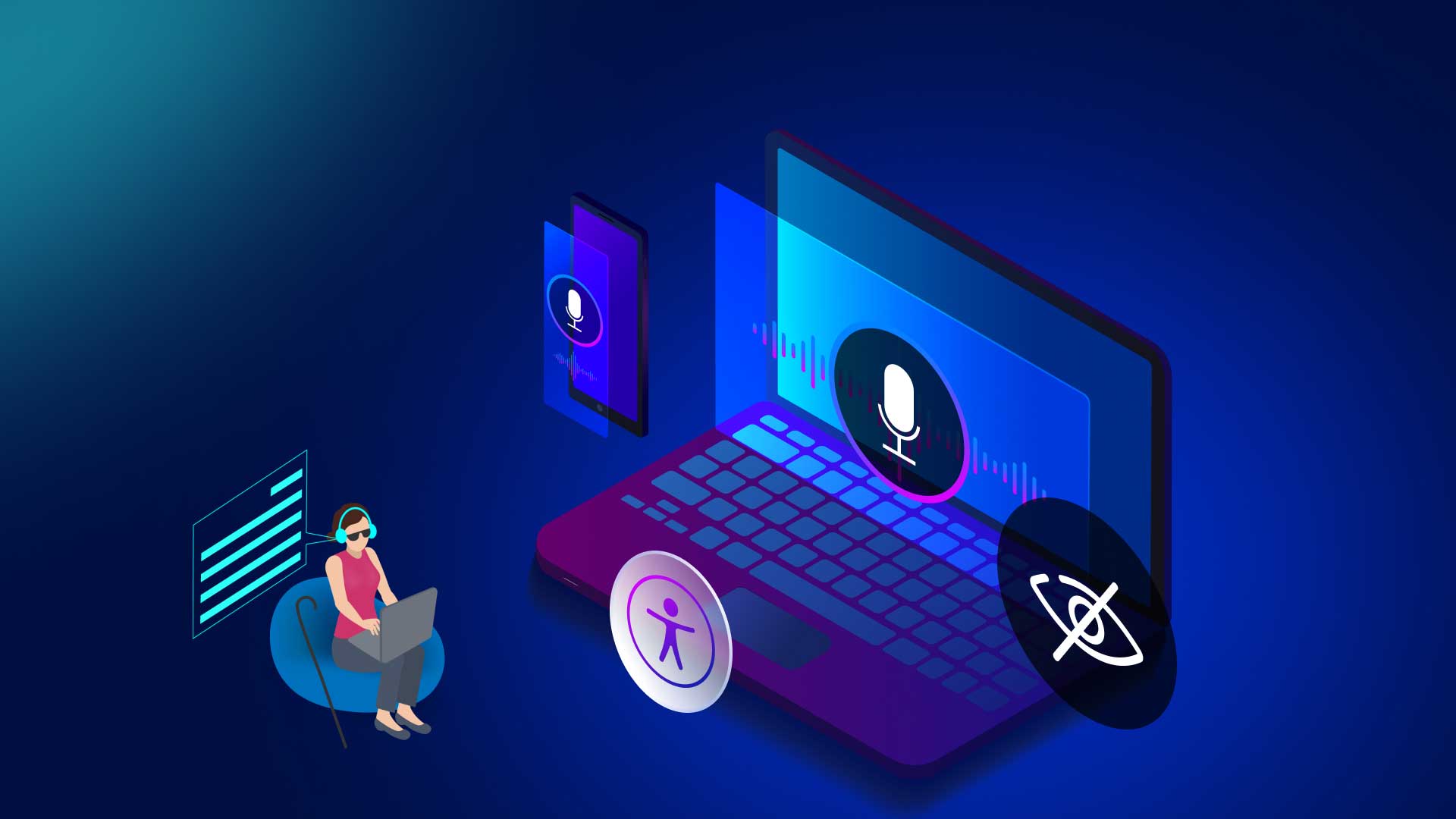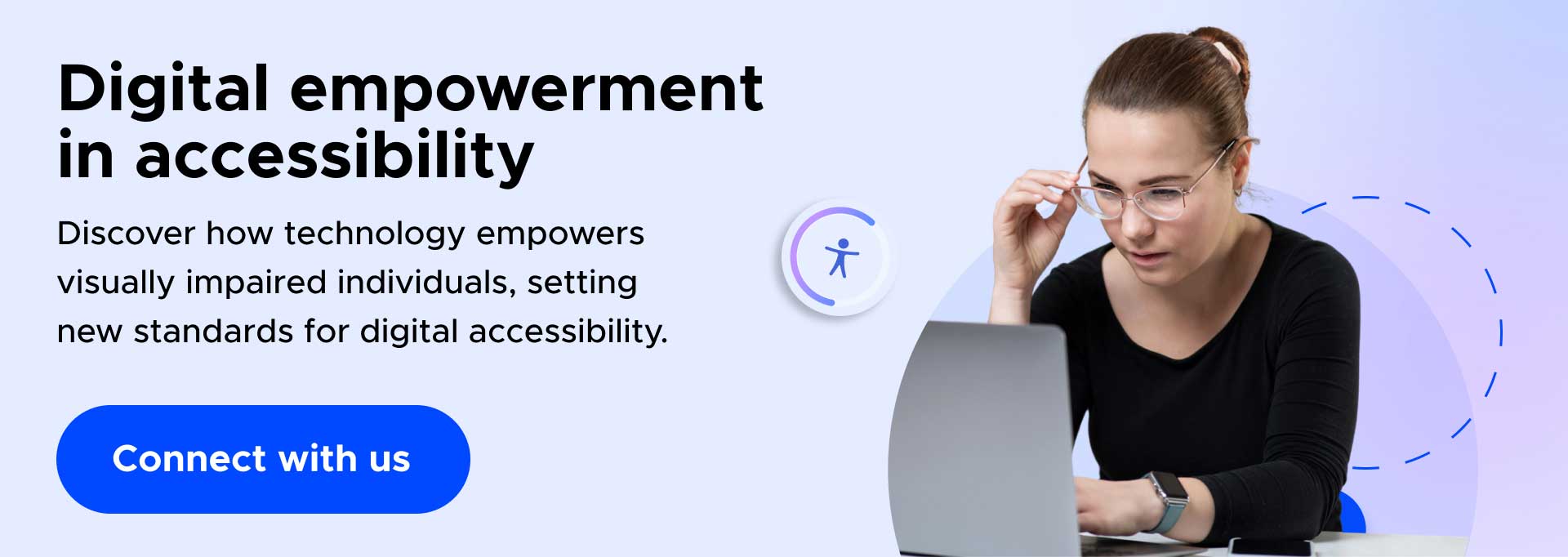Visually impaired and digitally empowered: setting the standard for accessibility

The internet is a lifeline for almost everyone. As a global marketplace, information resource, and a means of social connection, the digital world is a gateway to endless opportunities. Yet for the 285 million people around the globe with vision impairments, the web can feel more like an exclusive space full of barriers and frustrations. In short, digital accessibility for the visually impaired should be a top priority for any organization.
This blog breaks down the issue from the ground up, offering valuable insights into the business case for inclusivity and actionable steps to integrate website accessibility for the visually impaired.
What is Visual Impairment?
Visual impairment describes a range of vision-related conditions that impact people’s ability to see clearly and navigate the world. Globally, an estimated 2.2 billion individuals live with some vision impairment, illustrating the need for web accessibility to ensure that the digital world is inclusive, equitable, and available to everyone.
There is a wide range of visually impaired user experiences. Visual impairment isn’t a one-size-fits-all description, encompassing everything from low vision to mild vision loss to complete blindness. Some people may struggle with color differentiation (color blindness), while others may face challenges with depth perception or peripheral vision.
Visual impairments can also be congenital, present at birth, or acquired due to aging, disease, or injury. These factors will help determine the kinds of assistive technology for visually impaired individuals that you may implement on your website.
To successfully design accessible websites, including visual impairment accommodations, we must first understand the spectrum of visual impairments. Here are some examples:
1. Blindness: Complete or nearly complete loss of vision.
2. Low Vision: Limited sight that lenses can’t entirely correct.
3. Color Blindness: Difficulty in distinguishing between specific colors.
4. Glaucoma: Affects peripheral vision, potentially leading to blindness.
5. Diabetic Retinopathy: Diabetes-related, often causing fluctuating or blurred vision.
6. Macular Degeneration: Age-related impacts central vision.
7. Retinitis Pigmentosa: Affects night and peripheral vision.
8. Cataracts: Causes clouded, blurred, or dim vision.
9. Astigmatism: Causes blurred or distorted vision at all distances.
10. Photophobia: Light sensitivity often occurs with other visual impairments.
Fortunately, regardless of where individuals fall on the spectrum of visual impairments, assistive technology and other digital accessibility solutions can significantly enhance peoples’ online experience. Let’s examine how assistive technology can empower visually impaired people to navigate the digital world.
How To Create Better Websites for the Visually Impaired
Website technology has come a long way in accommodating those with various eye-related disabilities. It isn’t about replacing human capabilities but enhancing them with assistive technology specifically for the vision impaired.
1. Screen Magnification Software
Magnification tools for visually impaired users like ZoomText or Magnifier for Windows enable users to enlarge specific screen sections while navigating around a site, providing a tailored view without distortion.
2. High-Contrast Themes
These themes make text and icons pop. Color contrast accessibility involves modifying the color scheme to differentiate text from the background, aiding in clarity and readability. A contrast checker can help you ensure that text and background colors on your website and other electronic documents meet accessibility standards and optimize readability for all users.
3. Text-to-Speech Software
While this solution isn’t unique to low vision, text-to-speech software for visually impaired users can complement visual intake with auditory guidance. Platforms such as NaturalReader can turn website content into spoken words, providing an alternate way to digest information. Accessible graphics for visually impaired individuals also allow text-to-speech software to read alt text that concisely and accurately describes non-text content on the screen. Some applications also offer braille accessibility for individuals with both vision and hearing impairments, translating on-screen content into braille using a specialized device.
4. Customizable Cursors and Pointers
Think of these as your digital highlighters, drawing your eyes exactly where they need to go. Users can adjust cursors’ size, shape, and color to suit their needs, making navigation less of a scavenger hunt. These accessibility features for visually impaired users can also help people with motor issues that keep them from using a mouse, allowing them to use their keyboard to navigate websites and locate cursors and pointers easily.
5. Color Filter
Bright light from a screen or other sources prevents some people with low vision from reading and causes pain for some people. Color filters built into many operating systems adjust the color spectrum displayed on-screen to accommodate various visual impairments, including certain types of color blindness or light sensitivity. It’s like putting on tinted glasses designed just for you.
6. Voice Command Software
For some people, coordinating magnification while navigating can be hard work. Enter voice command software like Dragon NaturallySpeaking, which allows users to control their computers through voice, freeing them to focus on what’s magnified. However, this approach will only work if your content is optimized for screen reader accessibility. This involves adding headings and subheadings to the text, enabling accessible navigation for visually impaired users.
7. Electronic Handheld Magnifiers
These pocket-sized tools are among the simplest visual impairment support devices available. They magnify anything from restaurant menus to bus schedules and often come with built-in lights and color contrast settings. These devices can turn practically anything written or printed into accessible reading materials for visually impaired readers. Understanding and incorporating these assistive technologies can do more than make your site accessible; they can make it inviting, engaging, and genuinely usable for people with visual impairments.
Does the WCAG Apply to Web Accessibility for the Visually Impaired?
Meeting the unique needs and challenges of people with vision-related challenges makes the web more accessible and user-friendly. Following the Web Content Accessibility Guidelines (WCAG) is a great place to start.
WCAG are recommendations designed to make web content and electronic documents more accessible to people with disabilities, including those with visual impairments. Critical aspects of WCAG relevant to visual challenges include:
1. Perceivability: Provide text alternatives for non-text content and ensure multimedia has alternatives like captions.
2. Adaptability: Content should be usable under various adjustments, such as enlarged text or altered colors.
3. Distinguishability: Ensure clear contrast between text and background and provide controls for moving or blinking content.
4. Keyboard Accessibility: Ensure all site functions can be performed via keyboard, benefiting those who can’t use a mouse.
5. Predictability: Maintain consistent page structures for more straightforward navigation, especially for screen reader users.
6. Input Assistance: Highlight and help correct errors, especially in forms.
7. Compatibility: Ensure content works seamlessly with assistive technologies, from screen readers to voice recognition.
Why Should Websites be Accessible to People With Vision Impairment?
Below, we look at a cross-section of compelling reasons to digitally accommodate people with vision impairment:
- Audience expansion: Integrating digital accessibility opens your website to millions of people with disabilities with substantial buying power.
- The legal obligation: the Americans with Disabilities Act requires commercial websites to be accessible to people with disabilities by complying with the WCAG. The ADA also requires accessible documents for the visually impaired, such as PDFs and Word documents. Non-compliance can lead to expensive lawsuits and related legal complications.
- Preventing customer attrition: 285 million people have visual impairments worldwide. Can you really afford to turn away this substantial target audience? Any responsible business owner should see the ethical and business advantages of embracing accessibility for the visually impaired.
- Lawsuit mitigation: Embracing digital accessibility now is your best approach. Waiting until you’re vulnerable to non-compliance lawsuits puts you in an unenviable position. Now, you’re rushing to prepare a legal defense, which can take your eye off other crucial priorities. And why not prevent legal headaches while committing to inclusivity that bolsters your brand image?
- Prevent losing government business and funding: Federal government agencies are less likely to do business with you without digital accessibility. You also risk losing federal funding, contractual agreements, and support from federal websites.
- Claimable tax breaks: Small businesses can claim an annual federal tax credit for creating accessible apps and websites for visually impaired people and those with other disabilities if they earn $1 million or less and employ fewer than 30 staff members. But it’s still best to clarify these issues with a tax professional.
We can’t leave anyone behind in the digital age. All of us must champion the cause, embrace WCAG standards, and push for greater accessibility and inclusivity. Are you on board?
UserWay: Websites That Work for Everyone
Now that you know what you need to ensure your websites are accessible to everyone, the next step is action. If you’re ready to improve your accessibility and compliance, UserWay has a complete framework of AI-powered tools and support services to take you there.
Start your first chapter of accessibility today.
Common FAQs
Why is web accessibility important for visually impaired users?
It ensures equal access to information and functionality, enhancing inclusivity and user experience for everyone.
What tools do visually impaired users utilize for web navigation?
Assistive technology for visually impaired users includes screen readers, text-to-speech software, and magnification tools.
How do color choices affect website accessibility for the visually impaired?
Websites for visually impaired people use color choices that improve contrast and readability. Both factors are essential for users with color blindness or low vision to discern content effectively.





Share